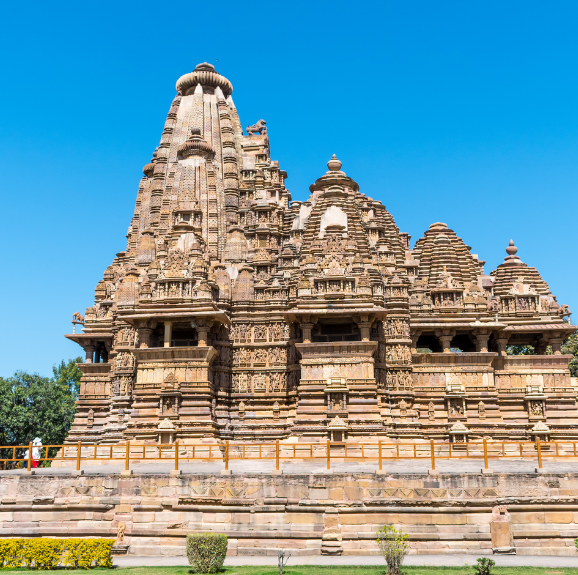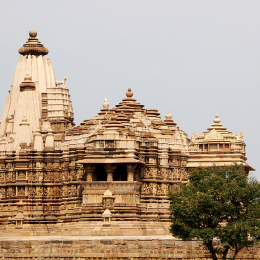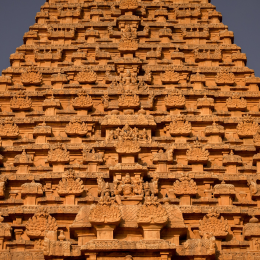Khajuraho, located in the central Indian state of Madhya Pradesh, is one of the most iconic and historically significant sites in India, famed for its UNESCO-listed temples and their remarkable architecture. Built between the 9th and 11th centuries by
the Chandela dynasty, the Khajuraho Temples are a unique blend of architectural brilliance, artistic expression, and cultural heritage. Today, Khajuraho stands as a symbol of India’s rich history and is
one of the country's most visited tourist destinations.
Khajuraho: A Glimpse of Ancient Indian Art and Architecture
Madhya Pradesh, India



Overview
Historical and Spiritual Significance
Khajuraho was once the thriving capital of the Chandela dynasty, which ruled over parts of central India between the 9th and 13th centuries. Under their reign, Khajuraho became a center of cultural and artistic achievements. The temples, primarily constructed
during the time of King Vijayapaladeva, reflect the grandeur of the Chandela dynasty and are a testament to their devotion to both religion and art. The temples were built using sandstone and designed to
honor Hindu gods, goddesses, and deities, with a particular focus on Shiva, Vishnu, and the Goddess Parvati.
At its peak, Khajuraho was home to more than 85 temples, though only around 25 temples remain today, spread across three main groups: the Western Group, the Eastern Group, and the Southern Group. The site is renowned for its remarkable architecture, intricate
carvings, and detailed sculptures that depict various aspects of Indian mythology, daily life, and celestial beings.
Architectural Mastery
The Khajuraho Temples are built in the distinct Nagara style of North Indian temple architecture, characterized by tall, spired towers that gradually taper toward the sky. These structures are primarily made of sandstone, which has been intricately carved
with detailed images. The temples are divided into three main sections: the sanctum (garbhagriha), the assembly hall (mandapa), and the tower (shikhara), with each part meticulously designed to represent
different aspects of the divine.
Among the temples, the Kandariya Mahadev Temple stands out as the most grandiose and architecturally significant. Dedicated to Shiva, this temple is the largest and most intricately decorated in the Western Group. The temple features towering spires that
symbolize Mount Meru, the axis of the world in Hindu cosmology. The exterior of the temple is adorned with beautifully detailed carvings that depict gods, goddesses, celestial beings, and scenes of everyday
life, showcasing the ancient Indian way of life and society’s cultural and spiritual richness.
Erotic Sculptures and Symbolism
One of the most fascinating aspects of the Khajuraho Temples is the famous erotic sculptures that adorn many of the temples. While these erotic carvings have drawn considerable attention from visitors and scholars alike, it is important to understand
that they form a small fraction (around 10%) of the total carvings across the temples. These sculptures depict couples in various intimate poses, but they also reflect a broader artistic and philosophical
context of Kama (pleasure) as one of the three central goals of human life in Hindu philosophy, alongside Dharma (duty) and Artha (prosperity).
These erotic carvings, along with depictions of dancers, musicians, and animals, illustrate the celebration of life, sensuality, and the human form. They also carry a deeper spiritual meaning, often symbolizing the union of the divine masculine and feminine
principles, highlighting the balance of life forces.
Key Attractions
Kandariya Mahadev Temple
Lakshmana Temple
Chausath Yogini Temple
Parsvanatha Temple
Vishvanatha Temple
Khajuraho is not just an architectural marvel; it is also an important cultural and spiritual center. The Khajuraho Dance Festival, held annually in February or March, is one of the most prominent events that celebrates the region’s vibrant cultural heritage.
The festival features classical dance performances, including Kathak, Bharatanatyam, and Kuchipudi, and is a showcase of India's ancient dance traditions in the backdrop of the stunning temples.
The temples also serve as a reminder of India’s rich artistic traditions, where the sacred and the sensual were intertwined. The intricate carvings offer a window into the spiritual, philosophical, and social lives of people during the Chandela dynasty,
preserving the region’s cultural heritage for future generations.
Conclusion
Khajuraho is a remarkable testament to India’s ancient architectural and artistic genius. The Khajuraho Temples, with their intricate carvings and majestic structures, continue to captivate visitors with their beauty, mystery, and spiritual depth. While
the erotic sculptures often steal the spotlight, they are just one part of a broader narrative that celebrates life in all its forms, from the sacred to the sensual. A visit to Khajuraho is not just a journey
through history but also a chance to witness the extraordinary legacy of the Chandela dynasty, whose artistic vision continues to inspire awe and wonder centuries later.

